Orthognal cut of two circle-
If two circle are cutting each other orthogonally then the tangents at the point of intersection is perpendicular to each other :-
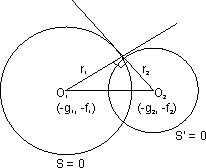
(O
1o
2)
2 = r
12 + r
22
(g
1 - g
2)
2 + (f
1 - f
2)
2 = g
12 + f
12 - c
1 + g
22 + f
22 - c
1
2g
1g
2 + 2f
1f
2 = c
1 + c
2
Illustration - The center of circle S .line on the line 2x - 2y + 9 = 0 and S cuts at right anges the circle x
2 + y
2 = 4 . Show that S passes through two fixed point and fond heir coordinates
Contre lies on 2x - 2y + 9 = 0
=> - 2g + 2f + 9 = 0 ..........(1)
So cuts x
2 + y
2 - 4 = 0 orthogonally -
=> 2g (0) + 2f (0) = c - 4
=> c = 4 ...............(2)
Using (1) and (2) the equation of S be come :-
x
2 + y
2 + (2f + 9) x ++2fy + 4 = 0
=> (x
2 + y
2 + 9x + 4) + f(2x + 2y) = 0
We can compare this equation with the equation the family of circle through the point of interectin of a circle and a line (S + FL = 0, where f is a parameter).
Hence the circle S always pass through two fixed point A and B . Which are the point of intersection of x
2 + y
2 + 9x + 4 = 0 and 2x + 2y = 0
Solving these equation we get,
x
2 +xy
2 + 9x + 4 = 0
=> x = - 4, -1/2 => y = 4, 1/2
=>A

(- 4, 4) & B

(- 1/2, 1/2)
Radical axes- Locus of a point which moves such mthat mthe tangents drawn from tjhis point oto the two given circle will be of equal in lingth .
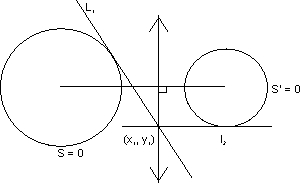
l
1 = l
2

S
1 = S
11
equation of radical axes

S
1 = S
11 = 0
Illustration- Find the equation of radical axes of the circle

S = x
2 + y
2 + 4x - 6y + 3 = 0
S
1 = 3x
2 + 3y
2 - 12x + 9y + 1 = 0
Ans- S
1 = S
11
=> x
12 + y
12 + 4x
1 - 6y
1 + 3 = x
12 + y
12 - 4x
1 + 3y
1 + 1/3
=> 24 x
1 - 27y
1 + 8 = 0
Important Results:-
(1)When circle are touching each other, the radical axes is the common tangent beween them.
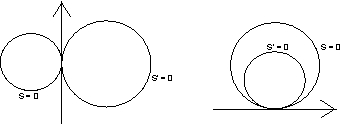
axes is common chord between them :-
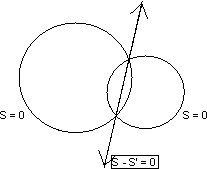 Radical centre
Radical centre- If there are thre circle (whose centre are not clooinear.) then there will be three radical axes. All these three radical axes are concurrent . And the point of concurrency is called radical centre.
* Radical axes are perpendical to kthe line Joining centre of the circles .
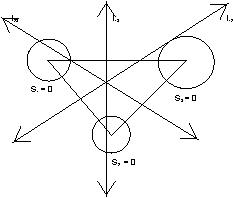
L
23
S
2 -S
3 = 0
L
12 
S
1 - S
2 = 0
adding above three -
L
13 = - (L
23 + L
12)
pair of lines.
Co axal System of circle-
A system of circle is said to be co axial when they have common radical axis ie, when radicaal axis of each pair of circles of system is same .
Illustration-
For what values of l and m the circle 5(x
2 + y
2) + ly - m =0 belongs to the coaxal system determined by pthe circle .
x
2 + y
2 + 2x + 4y - 6 = 0 and 2
2 + y
2) - x = 0 ?
Ans- If the radical axis for each pair of the three given circle is the same them the result is established.
Let the circle be .
S
1 = x
2 + y
2 + 2x + 4y - 6 = 0
S
2 = x
2 + y
2 - 1/2 x = 0
S
3 = x
2 + y
2 + l/2y - m/5 = 0
the equation of radical axis of circle S
1 = 0, S
2 = 0 is S
1 - S
2 = 0
ie, x
2 + y
2 + 2x + 4y - 6 (x
2 + y
2 - 1/2x) = 0
or, 5/2x + 4y - 6 = 0
or, 5x + 8y - 12 = 0 ......................................................(1)
the equation of the radical axis of circle S
2 = 0, S
3 = 0 is S
2 - S
3 = 0
ie, x
2 + y
2 - 1/2x - (x
2 + y
2 + l/5y - m/5) = 0
or, 5x + 2ly - 2m = 0 .................................................(2)
(1) and (2) must be identical, so comparing them,


l = 4, m = 6
(Q | ) Find the equation of a circle which touches the line x + y = 5 at the point A(-2, 7) and cuts the circle x
2 + y
2 + 4x - 6y + 9 = 0 orthogonally .
(A |)
Since the circle is touching the line x + y - 5 = 0 at
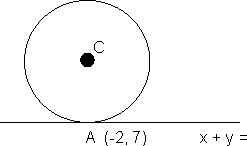
(-2, 7), its equation can be written as
(x + 2)
2 + (y - 7)
2 + K(x + y - 5) = 0 (whose k b vatiable
=> x
2 + y
2 + x (K + 4) + y(K -14) + 53 - 5 K = 0
It is orthogonal to the circle
x
2 + y
2 + 4x - 6y + 9 = 0
=> 2g
1 g
2 + 2f
1 f
2 = c
1 + c
2
=> 2(K + 4) - 3(K - 14) = 53 - 5 K + 9
4K = 12
K = 3

eqn of circle,
x
2 + y
2 + 7x - 11y + 38 = 0